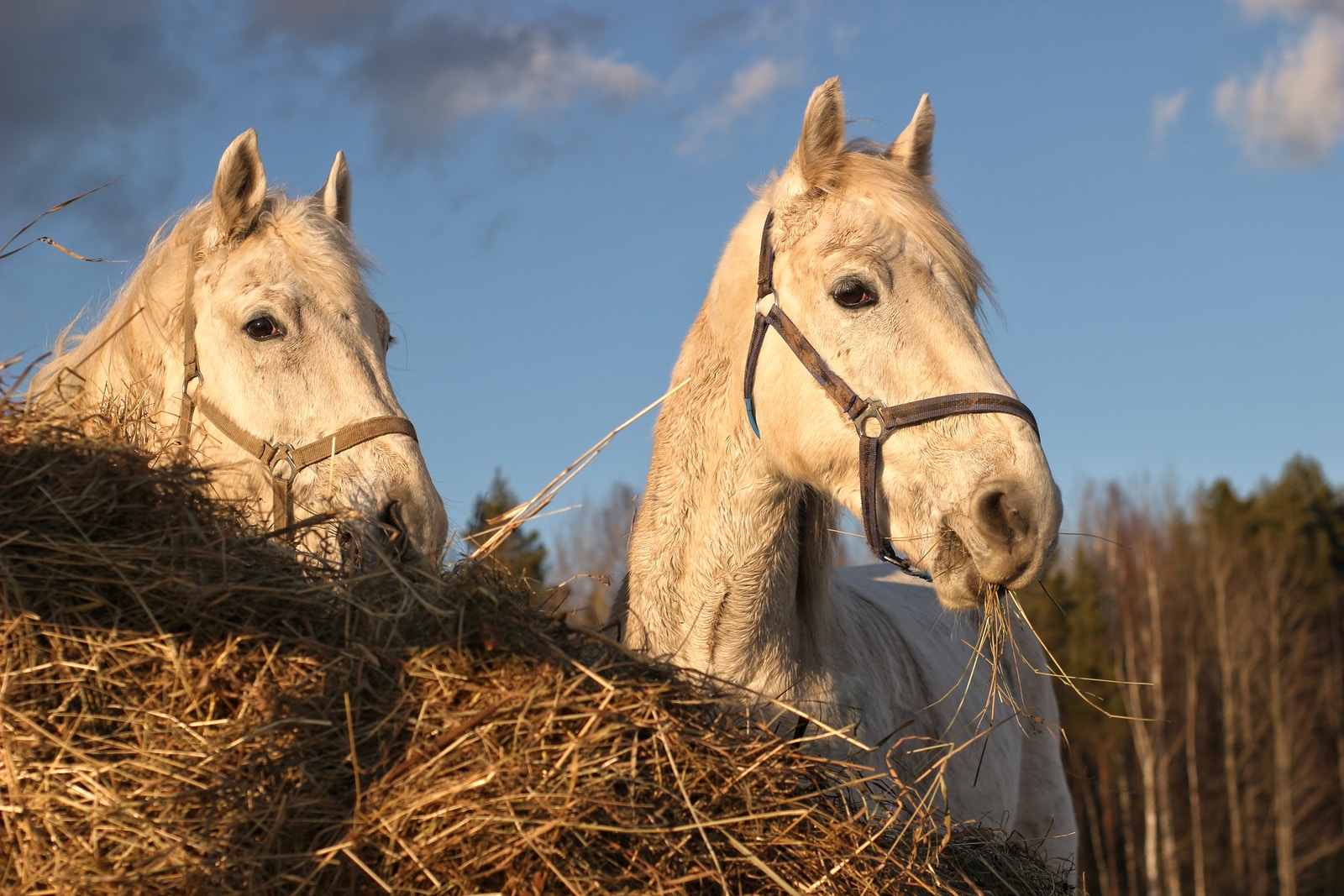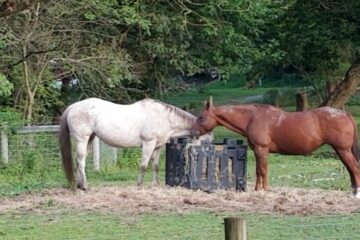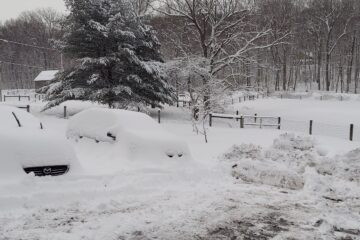Buying Hay for Horses

Here we are in May again and it’s the beginning of another hay season. Hay season has a special meaning to horse keepers. It is a time of anxiety and frustration since hay is typically the largest expense in the operating budget of the farm.
Many variables set the quality, quantity and type of hay that is available to us as horse keepers. Weather is probably the biggest variable and one that can’t really be managed. Weather is what it is and all we can do is work around it.
Other variables that play into the cost and availability of hay are equipment failures, labor availability and the judgment of the hay farmer.
I can’t control most of these challenges but I can offer you some insights in how to manage your hay to offset some of the angst.
Find a Good “Hay Guy”
Good hay guys can be hard to find since they usually have their entire crop of hay spoken for by their current customers but things always change and eventually you will find a match.
There are two types of hay sources; the grower and the broker.
Buying From the Farmer
Buying your hay directly from the farmer will usually get you the best price and some really nice hay of consistent quality.
The downside of buying directly from the farmer is that the farmer is typically a one or two person operation so they can make hay or deliver hay but they can’t do both simultaneously. From September through May this usually isn’t a problem since there is no hay being made but when your loft is empty in June getting a load of hay in can be problematic.
The other risk of buying directly from the farmer is that they usually have a finite amount of hay made so come April their loft may be as empty as yours.
Buying From a Broker
Buying from a hay broker will cost you more since the broker has to cover the expense of picking up the hay from the farmer, storing it at their facility, loading it back on their truck and then delivering it to your loft.
Buying hay from a broker can cost as much as 75% more than buying it from the farmer so why would you consider this option?
Convenience
My personal experience with buying directly from the farmer is probably much like the experience most of you have.
When hay is coming you need to line up some help to get it moved and stacked so you try to nail down your hay guy for a delivery. Saturday at 9 AM. K.
11 AM, “Jim, my mower broke this morning so I had to run for parts because tomorrow is Sunday. I’ll be there at 2.”
3:30 PM “Jim, the JD dealer didn’t have the parts so I had to drive 2 hours to pick them up. I’ll be there by 5.”
6:48 PM “Jim, my grandfather’s truck broke down so I had to go pick him up. I’ll throw 20 bales on the pickup to get you through until next week.”
I know you have all had at least one version of this conversation.
Once I began buying from a broker my hay cost went up by 30% but when I got home from work there were 200 bales stacked in my loft that I did not lay a finger on.
Availability
A good hay broker never runs out of hay. Near the end of the season some of the hay may be a little sketchy but your horses will eat.
Variety
Hay brokers will have access to most types of hay so if you have mixed hay requirements a broker can usually find what you are looking for.
Whether you are using the farmer or a broker it’s essential that you find a good, reliable source for your hay.
What Size Bale?
In general hay comes in three primary sizes; small square, big square and round. There are advantages and disadvantages to each. The key is to buy what works best for you.
Small Bales
Most of the smaller farms I work with feed small bales. Some large operations also feed small bales making small bales the most popular form of hay.
Small bales have many advantages for the horse keeper.
They are easier to handle for distribution and portioning especially in the stalls. Easier portioning and handling means less waste.
They are usually a higher quality since baling and curing small bales usually yields a higher quality product than the larger versions.
When you encounter a bad small bale it’s easily disposed of and it’s not a big hit on your hay supply.
Small bales come with penalties, however.
They are more expensive by weight than larger bales. This is also made worse because you may not be getting the best deal by weight. I’d rather pay $6 for a 40 pound bale than $5 for a 30 pound bale.
They are more labor intensive for the farmer and the keeper. Moving and stacking small bale deliveries is never a fun job.
Big Square Bales
Big square bales are larger cousins to small bales. They typically are tied with four strings and average about 700 pounds or 20 average small bales.
Large square bales typically cost from 30 percent to 50 percent less than the equivalent weight of small bales with very similar quality and available variety. The reason for this is that a hay producer can handle these bales without any need for additional labor. Once the bale bounces out of the baler the farmer simply lifts it with a tractor or skid loader onto the truck.
Of course this reduction in cost comes with a price…
A big square needs equipment to move once it’s delivered.
While a big square will peel into “flakes” or “laps” just like a small bale it’s not as clean or easy.
The incidence of having a bad bale is about the same as small bales, in my experience about 10%. The problem is that when you have a bad big bale it is a production to move it out of the loft.
I switched from small bales to big square bales last season because of cost and ease of handling delivery. Two people can unload the same weight of hay in large squares in 20 minutes versus four people and 45 minutes with small bales.
The first three weeks of the transition resulted in numerous F-bombs but my mantra was “You’re saving $4,000. You’re saving $4,000. Aaaaooowwwmm.”
In my case the change also required some creativity since my tractor isn’t large enough to lift these bales. My hay guy and I came up with a system.
I built a ramp into my loft. We back the truck up to the ramp and pull the bales off the truck onto the ramp. I then get on my trusty Kubota and push the bale up the ramp and into the loft. It’s actually pretty easily steered into place.
Large Round Bales
This is the most economical way of buying and feeding hay. The biggest problem with large bales is having the equipment to move them and the space to store them.
I know some keepers who will pick up round bales on their pickup truck, pull the truck into the pasture and roll the bale off the back. It’s one way to do it but you are constantly running for hay and if there’s a big snowstorm…?
Large bales can be very challenging to portion hay in the stalls.
For smaller herds there can be excessive waste because it will take a small her too long to eat a round bale.
Round bales can be inconsistent during the curing process so I’ve found them to be dusty and a lower quality.
Large Squares Seem to be the Best Compromise
My experience with large square bales is that they are the best compromise of reduced cost and inconvenience.
Hay Buying and Managing Strategies
Most horse keepers are living bale to bale with their hay. There are usually two reasons for this; space and budget.
Storage space is not always easy to expand but if you are buying small lots of hay because of budget I will explain why it’s worth looking at some cash management in order to change your hay buying habits.
Buy in Large Quantities
Like any other commodity buying hay in quantity will offer you the best cost.
Large deliveries will require more help but you need to line up that help less often.
Having a large quantity of hay in the loft will give you more flexibility in the event bad weather prevents a delivery or you need to shop for another source. Keeping a three week reserve of hay is liberating.
Think Ahead
Don’t start shopping for hay or a new supplier in June when your loft is empty. If you are thinking of making a change in your supplier, start when you have a loft full of hay.
Manage Your Inventory
Calculate your usage rate every two weeks. Keep a tally on how much hay you have and how much you use. Even though deliveries from your hay guy can be frustrating, you are not helping matters by calling the hay guy for a delivery when you only have two days worth of hay in the loft.
Keep a Reserve
Hay doesn’t go bad if it’s stored properly so keep a solid reserve handy.
Keeping a reserve will help you manage a number of contingencies like weather. If it’s pouring rain for three days it’s hard to run a load of hay. The same goes for a big snowstorm. Your hay guy may not be able to pull hay out of his maw or back into your loft for a week or more after a big snowfall.
Here’s my reserve strategy…
I can fit 16 large square bales in my loft. This is four months worth of hay for my horses.
When I am down to nine bales I will call to order eight bales for the following week. If my hay guy tells me he can make it this week but not next I will have him bring seven. If it turns out that he can’t make it for two weeks I will have him bring nine. Basically I want to bring my loft back to a full load of 16 bales.
When June comes around I stop ordering hay and feed the eight reserve bales I’ve kept. There are many advantages of having this reserve coming into the season.
We all know that hay is the most scarce at the end of the season so while everyone is scrambling to find hay I’m sitting on my stash.
If the weather holds off the hay season for a few weeks I’m covered and not losing any sleep.
Holding off getting my first load of hay until August gives me a better selection of hay from different sources. It also allows the new hay time to cure in the hay guy’s loft instead of mine so that when my hay arrives it’s finished the curing process and in its final state.
Having a two month reserve gives me time to react if I need to find a new hay source.
I realize that purchasing a large quantity of hay can be expensive but you do it every year and you’re going to buy it anyway so plan ahead just like a vacation account. I set up a separate savings account and I put hay money into it with every paycheck.
By managing your funds you can avoid a whole lot of stress over finding hay for the damned horses.

